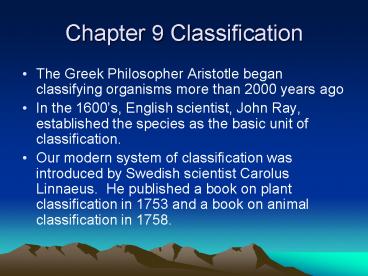Chapter 9 Classification PowerPoint PPT Presentation
1 / 16
Title: Chapter 9 Classification
1
Chapter 9 Classification
- The Greek Philosopher Aristotle began classifying
organisms more than 2000 years ago - In the 1600s, English scientist, John Ray,
established the species as the basic unit of
classification. - Our modern system of classification was
introduced by Swedish scientist Carolus Linnaeus.
He published a book on plant classification in
1753 and a book on animal classification in 1758.
2
Chapter 9 Introduction
- According to Linnaeus
- Organisms were classified according to their
structure - Plants and animals were arranged into genus and
species, and the categories of class and order
were introduced. - Species were given distinctive two-word names.
Linnaeus system is still in use today, although
with many changes - Carolus Linnaeus is the Latin translation of the
Swedish scientists given name, Carl Von Linne
3
Vocabulary for Section 1
- Classification
- Kingdom
- Phylum
- Class
- Order
- Family
- Genus
- Species
- Taxonomy
- Dichotomous Key
4
Section 1 Continued
- Please use your text and define the following
vocabulary words. Use graphic organizer 9-1 to
write your definitions. - Classification
- Kingdom
- Phylum
- Class
- Order
5
Chapter 9 Section 1
- Classification is about Sorting it all out.
- Classification stems from a need to organize
things around us. - It may be nice to know what plants you can eat
and which are poisonous. You may want to know
which animals you can eat and which will eat you. - Classification is the arrangement of organisms
into orderly groups based on their similarities.
6
Section 1 Continued
- Why Classify
- There are millions of different living things in
our world. - Making sense of the sheer numbers and diversity
of living things required classification. - Classification makes it easier for biologist to
find answers to many important questions, such
as - How many know species are there?
- What are the characteristics of each?
- What are the relationships between species?
7
Section 1 continued
- 7 Levels of classification used by biologist
- Kids Prefer Cheese Over Fried Green Spinach
- King Philip Came Over For Grape Soda
- Kingdom, Phylum, Class, Order, Family, Genus,
Species. - Can you name the 7 levels of classification?
8
Section 1 Continued
- What is the basis for Classification?
- Taxonomy The science of identifying,
classifying, and naming living things. - Initially, taxonomy attempted to classify
organisms only by their shared characteristics. - Later scientist began to realize that
evolutionary changes form a line of descent from
a common ancestor. Taxonomy changed to include
these new ideas about evolutionary relationships.
9
Section 1 continued
- Modern Classification.
- Taxonomists today classify organisms based on
presumed evolutionary relationships. - Species with a recent common ancestor can be
classified together. - See figure 4 in the text.
- Because of their common ancestor, an ancient
mammal, all four animals are based in the same
classMammalia
10
Section 1 continued
- The bear, lion and house cat, are more closely
related to each other than to the platypus. They
are all mammals, but only the platypus lays eggs. - Brown bears, lions and house cats, share a
different common ancestor, an ancient carnivore.
Thus, they are classified in the same order,
Carnivora.
11
Section 1 Continued
- You can take it even further and compare the lion
and the house cat. See page 203 of text. - Next session we will discuss Naming names and
Dichotomous Keys.
12
Section 1 continued
- Take time now to fill out the next five
vocabulary words on graphic organizer 9-1. - Family
- Genus
- Species
- Taxonomy
- Dichotomous Key
13
Section 1 Continued
- Naming Names
- By classifying organisms biologists are also able
to give them specific names. - A scientific name for an organism is always the
same no matter how many common names it may have. - The scientific name for the Indian Elephant is a
two word Latin name, Elephas maximus. All
scientist know that Elephas maximus is the Indian
elephant, and no other species uses this Latin
two word name. - Elephas in this case is the Genus, and maximus is
the species.
14
Section 1 Continued
- Why are scientific names so important?
- Anyone care to hypothesize?
- Does our discussion bring back any previous
knowledge? - Remember the Scientific Method and why certain
standards are used, all through the scientific
community.
15
Section 1 continued
- Dichotomous Keys
- Defined it is an aid in identifying unknown
organisms - The dichotomous key consist of several pairs of
descriptive statements that have only two
alternative responses. - By working through the statements the taxonomist
can eventually identify the organism.
16
Section 1 Review Exercise
- 1. Why do scientist use the scientific names for
organisms? - 2. Explain the two parts of a scientific name?
- 3. List the seven levels of classification?
- 4. Describe how a dichotomous key helps to
identify unknown organisms. - 5. Study the figure on the bottom of page 207.
Which plant is the closest relative of the
hibiscus? Which plant is most distantly related
to the hibiscus? Which plants have seeds?

